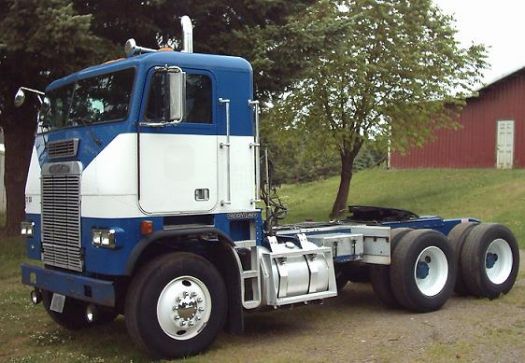Truck Topics
A Look Back at Cabovers
If one wishes to generate a lively discussion among veteran truck drivers, ask their opinions on driving cab over engine (COE) trucks. Drivers seem to either love 'em or hate 'em; just give them a minute and they'll tell you why.
Advocates of the flat-faced trucks will speak of the panoramic view from the driver's seat and the tighter turning radius of the cabover. Critics will
point to the harsh ride that comes from sitting over the front axle and it won't be long into the discussion before the cliche about the COE driver being the "first on the scene of the accident" is trotted out.

The concept of using a Class 8 COE truck as an expedited straight truck platform is a regularly recurring topic on the ExpeditersOnline Truck Talk Forum. The expediters posting on this topic are primarily interested in the increased cargo capacity that a cabover can offer when equipped with a 28' of 30' van body.
Where it began
The Wisconsin-based Sternberg company was producing cab over trucks as early as 1907. Their "Camel Back" model, introduced in 1933, allowed the cab to be tilted to access the engine.
The laws of the 1930's limited truck length to 42 ft. on highways, and by placing the cab over the engine, designers could eliminate cab space and use that area for cargo. In 1932, industrial designer Viktor Schreckengost and engineer Ray Spiller designed a cabover truck for the White Motor Company. The design was patented by Schreckengost in 1934.
One of the milestones in the COE timeline must certainly be when a trucking company CEO decided to do it himself.
In the late 1930s, Leland James, president of Portland, Oregon-based trucking company Consolidated Freightways (CF), sought a lighter, more durable truck that could haul more payload and bring in more revenue for his company. James decided to hire a group of engineers and build the vehicles himself.
Featuring a cab-over-engine design and extensive use of aluminum, James' trucks WERE lighter and more durable than those of the competition. In 1942, the manufacturing company James had established changed its name to Freightliner Corporation, thus giving birth to the company that would become North America's leading heavy-duty vehicle manufacturer.
As the decades rolled by, the COE tractor became an industry standard, with virtually all of the U.S. truck manufacturers offering the design. But in 1980, things began to change - change in the form of deregulation.
Rules that had kept freight rates artificially high were loosened significantly by the Motor Carrier Act, while at the same time the federal overall length laws were relaxed.
The COE design had originally resulted from the need to shorten the cab to increase trailersà cubic capacity and payload when overall length was regulated. Now only the trailer length had to meet a standard, and it had increased, too.
It was around this time that increasing fuel prices made truck aerodynamics of vital concern to designers. Cabover models such as the International 9700 with its rounded corners and "smoothed-out" surfaces made their debut.
Some feel the pinnacle of aerodynamic COE design was reached with the Peterbilt 372, introduced in 1988. Its most distinctive feature, along with a rounded front and curved two-piece windshield was a visor that stood out from the roof and allowed airflow behind it.
Though many drivers found the 372's design too radical and labeled it the "football helmet", the truck enjoyed a degree of acceptance in the late '80's and early '90's.
Cabover history highlights
1936
Kenworth introduces its ìbubble-noseî cab-over-engine truck.
Late 1930s
Leland James, president of Consolidated Freightways, oversees design of an aluminum cab-over-engine design tractor.
1942
Freightways Manufacturing, introduces the FTL cabover.
1950
Peterbilt introduces its first cabovers, the Model 280 and Model 350, commonly called ìbull-noseî tractors.
1950
Hyster becomes the first private carrier to order a Freightliner cabover.
1953
White-Freightliner introduces a cabover with an overhead sleeper to maximize cargo capacity.
1953
Mack introduces its H Series cabover, nicknamed ìCherry Pickersî because of the high cab.
1954
Peterbilt introduces its Model 351 cabover.
1956
Kenworth introduces its flat-faced cabover model CSE (cab surrounding engine).
1959
GMC replaced its ìbubble-noseî cabovers with the ìCrackerboxî Series, so named because of its very square look.
1958
White-Freightliner introduces the first tilting cab over design which allowed the entire cab to tilt forward to access the engine.
1959
Mack introduces its flat-face G Series cabover.
1959
Peterbilt introduces its UniLite 352 and UniLite 282 cabovers, nicknamed the ìPacemaker.î
1959
White Trucks introduces its 5000 Series cabover.
Late 1950s
International introduces its cabover Emeryville line, nicknamed the ìHighbinder.î
Early 1960s
Ford introduces its H Model cabover, nicknamed the ìTwo-Story Falcon.î
1963
Marmon Motor begins building road trucks, offering only cabovers until 1970.
1964
Dodge Truck introduces its L Series cabover.
1965
Freightliner introduces its TurboLiner cabover, powered by a gas-turbine engine.
1965
International begins phasing out its Emeryville cabover and introduces its CO-4000 Series cabover.
1966
Ford introduces its W Model cabover.
1968
GMC replaces its ìCrackerboxî cabover with the Astro Series cabover.
1972
White Trucks introduces its Road Commander cabover.
1975
The action film White Line Fever ó about an independent trucker and his ìBlue Muleî Ford W9000 cabover ó hits theatres.
1976
Kenworth introduces the industryÃs first raised roof cabover sleeper, the K100 Aerodyne.
1978
The television show B.J. and the Bear ó about a trucker (Billie Joe McKay) and his pet chimp companion (Bear) who travel around the country in a Kenworth 108-inch Aerodyne VIT cabover tractor pulling a refrigerated trailer ó airs from October 1978 until May 1981.
1978
Ford introduces its CL9000 cabover with an advanced cab air suspension system.
1981
Peterbilt introduces its Model 362 cabover, replacing the Model 352 as its flagship cabover.
1982
The Surface Transportation Assistance Act of 1982 was enacted. It abolished overall-length restrictions for tractor-trailers on the nationÃs Interstate Highway System.
1986
Until about 1986, the cabover was the most popular configuration in the U.S. because of overall length laws. However, after the Surface Transportation Assistance Act of 1982, the conventional started to become the overwhelming truck of choice.
1988
Peterbilt introduces its aerodynamic Model 372 cabover, nicknamed the ìWinnebago."
1993
Peterbilt ceases production of its Model 372 cabover.
1995
Navistar International introduces its International 9800 Flat Floor cabover.
1998
Freightliner introduces its Century Class Argosy cabover.
Late 1998
Navistar International reports: ìSince 1988, the cabover segment of the heavy truck industry has declined by approximately 90 percent.î
1999
Navistar International ceases production of its International 9800 cabovers.
2002
J.B. Hunt and Freightliner announce an agreement to replace HuntÃs cabover fleet with new conventional tractors.
2005
The last Peterbilt Model 362 cabover rolls off the line.





